Contents
- Basic Tips for Driving on Sand
- Three Common-Sense Driving Tips for Beaches
- Recovery Techniques for Being Bogged in Sand
- Summary of Driving in Sand
Introduction
Driving in sand while off-roading can be a challenging experience, whether it’s on a tropical beach or in the desert. Many people find themselves getting stuck in the sand, which can be frustrating and time-consuming. However, by following some basic principles, it’s possible to drive on sand without getting stuck. It’s important to note that this article focuses on general sand driving, not desert driving, which is a more complex topic. Paul Sinkinson, a consultant, trainer, and program developer who specializes in 4WD defensive driver training, created the content for this article. By following the tips outlined in this article, drivers can avoid becoming members of the “digging club” and enjoy a safe and enjoyable driving experience on sand.

Basic Driving in Sand while off-roading Tips
Driving in sand while off-roading can be tricky and requires a certain level of skill and knowledge. Here are some basic tips to help you navigate the sand safely:
- Recognize surface conditions: A variety of conditions may co-exist, so it’s important to learn how to recognize them. If unsure, carry out surveying of the area on foot.
- Beware of “wet sand”: These areas can seem bottomless and usually require assistance from other vehicles with a winch to extricate.
- Engage the right gear: Engage high ratio 4wd for long beach runs on hard sand. Engage low-ratio 4WD for soft sand and dunes to avoid overheating transmission.
- Avoid sharp turns and wheel spin: Sharp turns and wheel spin can cause the vehicle to get stuck. To avoid this, utilize speed for controlled momentum and keep gear changes to a minimum; normally, choose a gear and stay in it to avoid baulking.
- Lower tire pressure: Low tire pressures are highly recommended to increase the surface area of the tire and improve traction.
- Choose the right spot to stop: If it becomes necessary to stop on soft sand, try to choose an area that allows a downhill restart. To get re-started on flat, soft, dry sand, reverse 1-2 meters and form hard sand ramps so as to get a good starting speed before hitting soft sand again.
- Ascending sand hills: To ascend a sand hill, utilize controlled momentum. If you fail to ascend, back down the same wheel tracks far enough to allow a faster approach up the same wheel tracks.
- Descending sand hills: To descend, keep vertical to the sand hill/descent and avoid brakes. Accelerate gently if necessary to aid descent.
By following these basic tips, drivers can navigate the sand safely. However, it’s important to note that driving on sand can be dangerous, and drivers should always exercise caution and be prepared for unexpected situations.
There is Nothing Quite Like Driving on Sand
Driving in sand while off-roading is an exhilarating experience that can be both challenging and rewarding. It requires a unique set of skills and techniques that are different from driving on other types of terrain. The feeling of gliding over the sand dunes is truly unmatched and can be an unforgettable experience for any off-roader.
To drive on sand, it is important to reduce tire pressure to increase surface area, which will help maintain traction and prevent sinking. Maintaining momentum is also crucial when tackling dunes, as stopping or slowing down can cause the vehicle to get stuck. Drivers should also be aware of the dangers of driving on sand, such as hidden obstacles and sudden drops in elevation.
Overall, driving on sand requires a combination of skill, technique, and caution. With the right preparation and knowledge, it can be a thrilling and safe adventure for any off-roader.
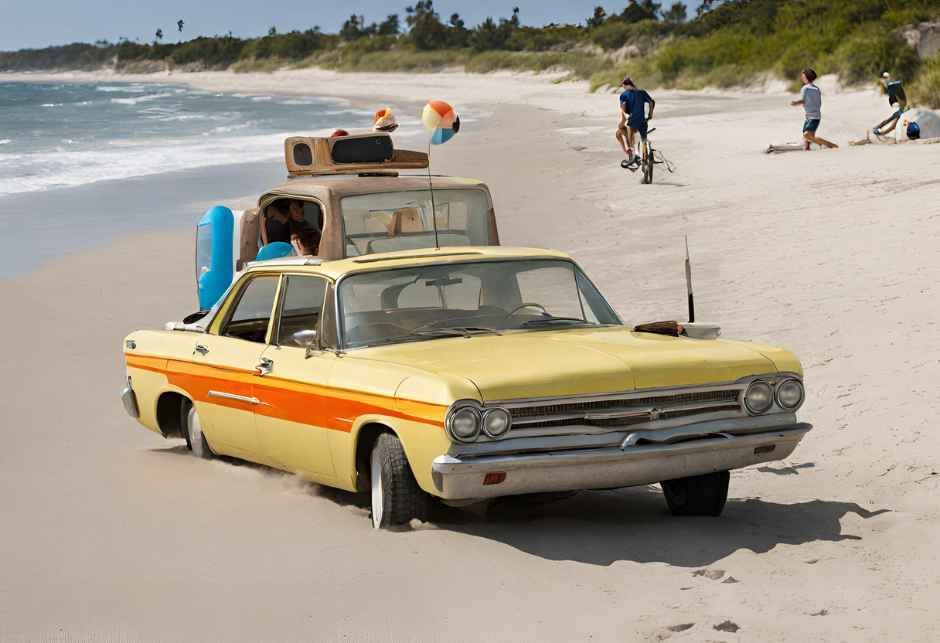
Beach Sand
Beach sand is distinct from desert sand. It is usually coarser in texture and can be more forgiving. It can also be wet or waterlogged due to its proximity to the sea. Away from the water’s edge, there may be dunes with or without vegetation. Some areas have larger dunes, similar to those found in the desert. While these dunes may look similar, they are very different. Desert driving requires a lot of space for discussion on techniques.
Driving on the beach can be dangerous. While the scenery may be beautiful, it is not a playground for trucks. In a 4WD vehicle, the beach can be one of the most dangerous places to drive. The normal hazard identifications when off-roading apply. It is important to read the earlier article on hazard identification on the site.
When driving on the beach, it is important to keep in mind that the sand can be dry, gravelly, and have rocks. It is also important to remember that driving on wet sand is different from driving on dry sand. Wet sand can be more challenging to drive on, and caution should be exercised.
Some tips for driving on beach sand include reducing tire pressure to around 15-20 psi, which can make it easier to drive on sand. It is also important to take a few extra precautions, such as avoiding sudden movements and staying away from the water’s edge. When turning, it is important to turn gradually and avoid sharp turns. It is also important to be aware of the tide and not to park too close to the water’s edge.
In summary, driving on beach sand can be challenging and dangerous. It is important to exercise caution and follow the normal hazard identification procedures when off-roading. By taking the necessary precautions, drivers can enjoy the scenery and fresh air without putting themselves or others in danger.

Three Common Sense Driving Tips for Beaches
Driving on the beach can be a fun and exciting experience, but it’s important to keep safety in mind. Here are three common sense driving tips to help you stay safe while driving on the beach:
- Stay out of the sea: Salt water can cause serious damage to your 4WD vehicle. Driving in the sea can cause salt water to get into the chassis and body components, leading to rust erosion. In addition, vehicle electrics and water do not mix well. Hot radiator fins are thin, and if salt water passes through them, the salt deposit can remain and eat its way into the core. To avoid these issues, it’s important to stay out of the salt water and keep your vehicle on the beach sand.
- Drive slowly: Although the beach sand may look dry on the surface, it can be soggy underneath. The tide comes in and out twice a day, which means that the sand can be wet and soft in places. To avoid getting stuck, it’s important to keep your speed down. You can drive in either high or low range, but it’s important to keep your speed under control.
- Drive in straight lines and avoid sharp turns: When driving on the beach, it’s important to keep your vehicle moving in straight lines. Avoid sharp turns, as they can cause a front wheel to dig into the softer areas of the sand, which can act as a brake and cause weight to transfer onto the wheel, increasing the risk of a rollover. If you need to turn, slow down and turn in a wide arc to avoid putting too much weight on one wheel.
Remember, driving on the beach can be dangerous if you don’t take the necessary precautions. To stay safe, it’s important to watch instructional videos on driving on sand and to avoid driving like some of the reckless drivers in videos that highlight bad driving on the beach. Finally, always make sure everyone in the vehicle is wearing their seat belt and avoid letting kids hang out of the sunroof or side windows. By following these common sense driving tips, you can enjoy a safe and fun experience on the beach.

Driving on Sand
Driving on firm sand is possible if the driver takes notice of the previous three tips. However, driving on softer sand is a different matter altogether. Traction can be at a premium, and any increase in speed may be difficult if not impossible. To make headway, it is important to maintain momentum. Losing momentum can result in the vehicle becoming bogged down. If the driver loses traction and experiences wheel-spin, it is important to abort immediately. Engage reverse gear and “gently” try to drive out along the existing tracks. If the driver does not abort, they will dig themselves in further, making it more difficult to get out.
Remember, driving on sand requires a different set of skills and techniques than driving on other surfaces. It is important to be prepared and take necessary precautions to avoid getting stuck or damaging the vehicle.
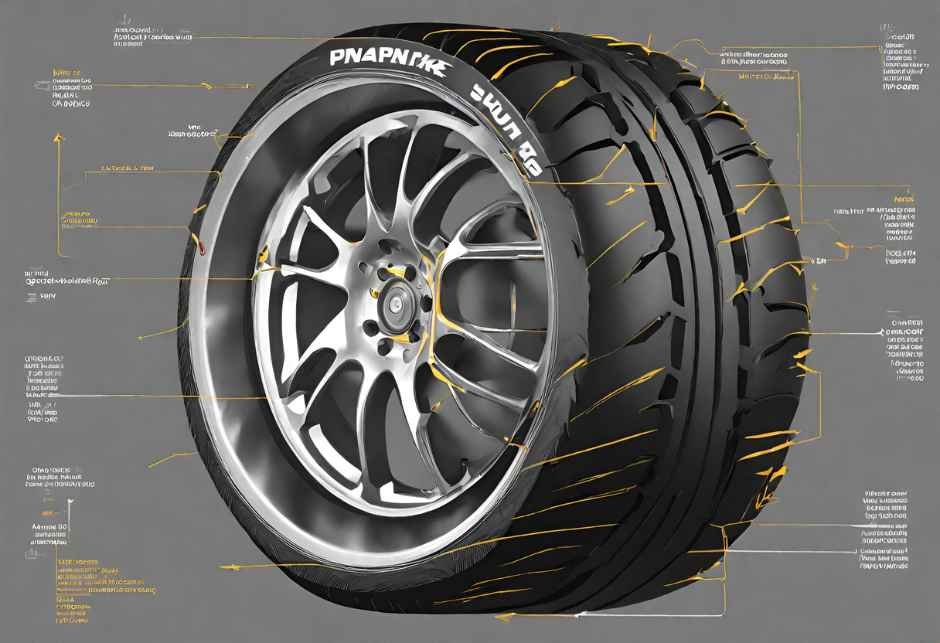
Tyre Pressures
When driving on beach or coastal sand, it is recommended to reduce the tyre pressures to improve traction. Lowering the tyre pressure provides a better footprint, which reduces the ground pressure and allows for better “flotation.” This, in turn, improves traction and reduces the strain on the vehicle’s steering components, power unit, and transmission.
Contrary to popular belief, reducing the tyre pressure does not make the contact with the ground wider. Instead, the tyre footprint becomes longer, although there may be a slight increase in width. For general sand driving, a tyre pressure of approximately 15 to 16 psi is recommended.
However, before reducing the tyre pressure, it is essential to ensure that you have a suitable pump to re-inflate them when you come back to normal roads and tracks. If you do not have a pressure gauge, you can use the old explorer’s trick of using a stick or a small rock placed an inch away from the edge of the tyre sidewall. On the average 4wd tyre of say 235x85x16, if you now let the air out of the tyre valve until the sidewall touches the stick on each tyre, you should have all the tyres down to the same level and roughly with a suitable amount of deflation.
It is important to remember that with lower ground pressure and perhaps with the bulging side-walls, the tyres are more susceptible to wear or damage. Therefore, you need to balance the risk when lowering the pressure between the increased traction it delivers and the possible tyre damage and wear. The correct balance will certainly make the difference between being bogged in the sand and driving a way through it.
If you are severely bogged into the sand, you can reduce the pressures further to around 10 psi, but not below 6 psi. Otherwise, the tyre may unseat itself from the wheel rim, resulting in it rolling off completely and being damaged. Speed must be kept to a minimum when tyre pressures are low, or you could lose directional control.
It is essential to note that these recommendations are only for sand driving and should be increased for driving on stone, rock, or hard surfaces. Before reducing the tyre pressure, it is important to ensure that you have a suitable pump to re-inflate them when you come back to normal roads and tracks.
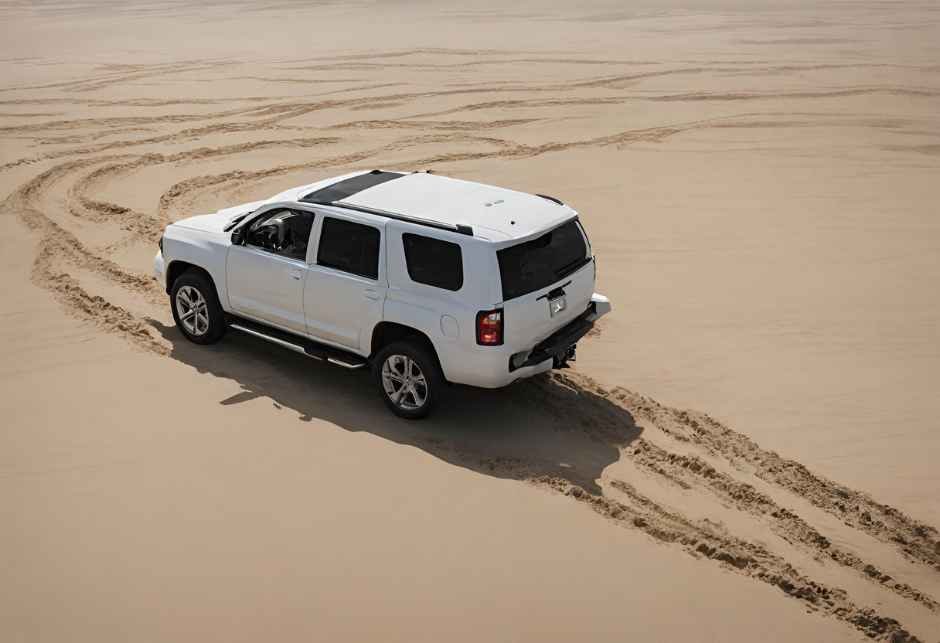
Now What to Do Behind The Wheel While Driving on Sand
Driving on sand requires a different set of skills compared to driving on regular roads. To ensure a smooth and safe drive, it is important to follow some basic rules.
Firstly, when driving on sand, it is best to follow in the tracks of the vehicle in front of you as they have already compressed the sand to form a firmer surface than “virgin” ground. However, if too many vehicles have disturbed the sand surface, it may be necessary to take a slightly different route to avoid getting bogged in.
It is important to avoid driving on natural or planted vegetation as this may destroy it, leading to environmental damage and erosion.
When setting off, it is advisable to undertake the process as smoothly as possible, making gear changes at higher revs than normal. Driving in sand requires plenty of power from the engine to get the vehicle moving on the sand but not so much that the wheels spin and dig into the sand.
It is recommended to initially drive forwards in a straight line in sand. This is because turning the steering wheel to half lock will slow down the vehicle due to the resistance of the sand and the increase in engine load.
While it is often suggested to use low range when driving on sand as it multiplies the amount of engine torque at your disposal, it is not always necessary. In fact, it may be better to drive in high range over most sand areas. When the sand surface deteriorates, that’s the time to consider the advantages of the low transfer gears.
It is important to avoid dramatic or excessive changes of speed or braking when driving on sand. Accelerating too quickly is likely to dig the wheels in, and heavy braking just pushes a sand wall in front of the tyres, making it harder to set off again.
If you have to stop on sand, it’s always best to depress the clutch on a manual and let the vehicle coast to a standstill. This way, there is no build-up of sand in front of the tyres, making for an easier start afterwards. On an automatic, slipping into neutral achieves the same effect. If the terrain permits, it is best to come to a halt on a slight downgrade rather than uphill, as this too makes for an easier restart.
Before setting off again, it is advisable to reverse a couple of yards on the pre-compressed sand to ensure a good start.
Remember, when you need to stop on sand, don’t brake. Depress the clutch on a manual and coast to a halt to avoid a build-up of sand in front of the tyres. Always try and halt on a slight downgrade rather than uphill for the same reason. For automatics, just back off the power and you will roll to a halt in the same way.
By following these basic rules, drivers can safely and confidently navigate through sandy terrain.
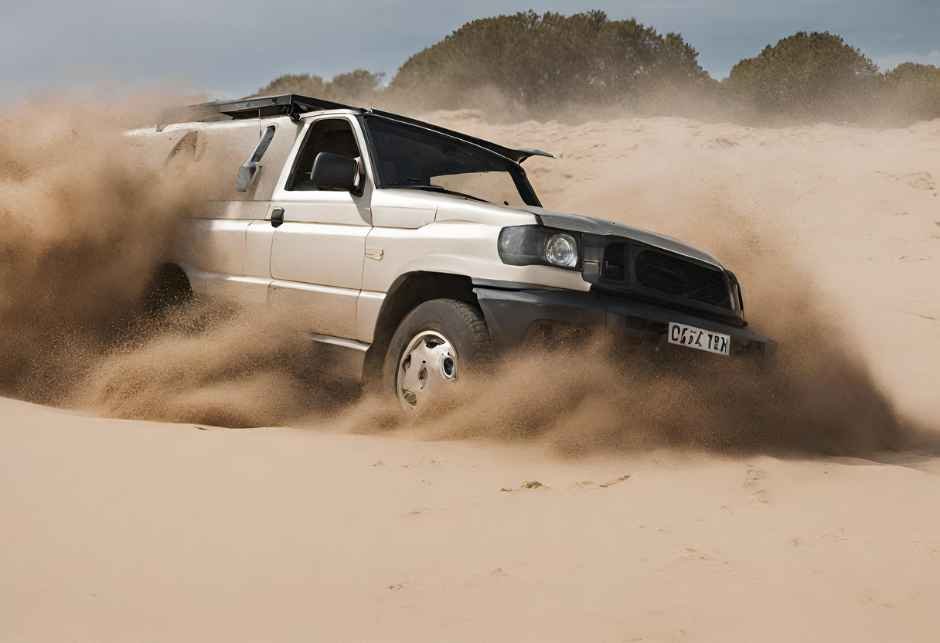
Turning in Sand
When turning in sand, it is important to make wider arcs than normal to avoid putting strain on the systems and to prevent the drag from the tires from causing a braking effect. Turning sharply in sand can cause centrifugal forces that result in weight transfer to the outside wheels, which can dig in and cause extra sideways braking forces. This can lead to a rollover. Therefore, it is recommended to turn at a reduced speed to avoid this. Always make wide arcs when turning as turning tightly in the sand can act like a brake and bog you down.

Beach Dunes
Beach dunes are often not too high and may have vegetation on them to reduce erosion. It is important to keep off them as they are protected for a reason. However, some beaches have massive dunes nearby that resemble desert dunes. These dunes require caution and respect as they can be dangerous to drive on.
If you have legal access to sustainable dunes or if you are fortunate enough to adventure in the desert regions, it is important to remember that dunes are not play-pens. They require a certain level of skill and knowledge to navigate safely.
When driving on beach or desert dunes, it is important to maintain momentum due to the braking effect of the sand surface. However, drivers must be cautious not to gain too much speed, as it may lead to accidents. The back to basics phrase “As slow as possible, as fast as necessary” is a good rule of thumb to follow when driving on dunes.
The sand just before the crest of a dune is usually very supple, and drivers must have enough momentum to pass through it without becoming airborne. It is important to always be aware of what is over the other side of the dune, and it is best to walk and check it out if uncertain.
Steep sand dunes should only be driven straight up or straight down. If driven at even a slight angle, the weight transfer is to the downhill side wheels, and if the vehicle starts to slip in the loose sand, the downhill wheels tend to dig in, making the angle of the dune even worse, potentially leading to a rollover.
When descending steep dunes, low range first gear should be avoided as it creates too much of a braking effect, especially in deep supple sand, where the front tires may dig in. Second gear or even third gear may be better as a steady and continuous descent is required. If the front wheels dig in, the rear wheels may start to slip sideways, and the recovery sequence is to accelerate slightly to try and straighten the vehicle.
It is important never to use the brakes when descending a steep dune, as this will cause further weight transfer to the front wheels, increasing the back end movement. Once the situation is recovered, continue to the dune base, but avoid acceleration off it as the sand may be soft. If the front wheels dig in, followed by the front bar, the vehicle may roll over base over apex.
When ascending a dune, if the climb fails, reverse down the dune in gear, never coast down the dune, and never attempt a U-turn. The same ascent and descent rules apply on dunes as to all other terrain.
In summary, driving on beach or desert dunes requires skill, knowledge, and caution. Drivers must maintain momentum, but not gain too much speed, and be aware of the supple sand just before the crest of a dune. Steep dunes should only be driven straight up or down, and low range first gear should be avoided when descending. Drivers should never use the brakes when descending a steep dune, and avoid acceleration off the dune base.
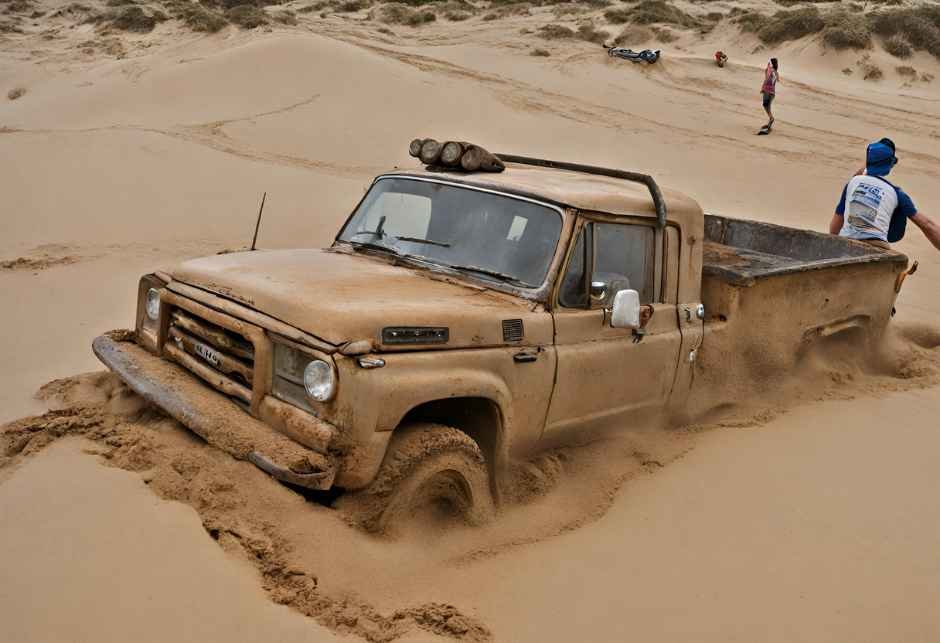
Recovery From Being Bogged in Sand
Getting stuck in sand can be a frustrating experience, but there are several ways to recover from being bogged in sand. The following are some basic themes to consider:
- If the vehicle went in forwards and is not fully bogged, it may come out fairly easily if reversed. Don’t try to plow on forwards or the vehicle will sink deeper. Reverse gently over the tracks as they should be compacted. Remove any sand built up behind all four wheels first so that the vehicle has a smooth restart in reverse.
- If an accompanying vehicle is available, it may be better to be recovered backwards. Ensure the other vehicle turns around so it is driving forwards away from the bogged vehicle as it tows it out. Remember to clear around the wheels before the tow out and avoid a big snatch pull. A gentle tug should get the vehicle started and allow the tow vehicle to proceed without bogging down. Once the vehicle starts moving, keep going but don’t crash into the towing vehicle.
- If the vehicle is well bogged down, a lot of digging out may be necessary. This is hard work, and it is essential to drink plenty of water to avoid dehydration. In extreme cases, reducing the tire pressures down to circa 6 psi may be necessary, but remember to re-inflate them once recovered, or they could roll off the rims.
- Sand ladders can also be used for recovery but need to be well placed under the wheels regardless of the direction intended for recovery. There are several ways of doing this without the need for too much digging. First, if a suitable “Air Bag Lift” is available, it can be used. Second, if there is a suitable accessory bridal and hook strop that fits a high lift jack, it can be used. Techniques for using these bits of kit will be added in a later recovery article.
- Winching may also be an option, but it is important to consider what to winch off. Specific techniques for this will be added in a future recovery article.
- Snatch strap/rope recovery is another option but is possibly the most dangerous. The same rules for extraction/recovery apply to sand as they do to most other bog-ins, and the equipment is basically the same. The same safety rules apply, as does the approach, “Do it once, do it right!”
Digging a bogged vehicle from sand is hard and tiring work. It is a good idea to wear gloves to avoid blisters from the shovel, and remove watches and rings as they can come off and get lost in the sand. Drinking plenty of water is essential to avoid dehydration.
In summary, there are several ways to recover from being bogged in sand, depending on the situation. It is important to consider the options carefully and choose the most appropriate method for the situation.
Driving in Sand Summary
Driving in sand requires a different set of skills than driving on regular roads. Lowering tire pressures can generally improve traction and reduce track erosion. However, it is important to re-inflate them to correct pressures for road work for the trip home. Always drive sensibly using smooth gear changes with higher than normal engine revs. Make sure the front wheels are pointing straight ahead when starting off.
It is crucial to remember that soft sand congregates at the base of gullies and dunes. Always make wide turns to avoid bogging. NEVER traverse across the face of a dune, ONLY travel straight up or straight down. Usually, it is best to follow in the tire tracks of other vehicles and to drive on compressed ground.
Coast to a stop rather than using the brakes to prepare for easier start-offs. Excessive flooring of the accelerator when you are “bogging” down will only make the situation worse. If you find you are starting to get bogged, try to reverse out along your own tracks.
After any beach or sand trip, it is important to thoroughly “Jet Wash” your vehicle to get rid of any Salt/Sand deposits. Remember those Geometric Limits mentioned in a previous article in the Training Pages! Make sure you have sufficient momentum to drive over the crests; otherwise, you get to join the “Digging” Club.
It is essential to follow these guidelines to avoid getting stuck in the sand and causing damage to the vehicle. Always be aware of the challenges of driving in sand and follow the tips provided to ensure a safe and enjoyable off-road experience.
Frequently Asked Questions
Is it better to drive fast or slow on sand?
When driving on sand, it is better to go slow. Driving fast on sand can cause the vehicle to lose traction, spin out, and get stuck. Going slow allows the vehicle to maintain traction and reduces the risk of getting stuck.
What are some off-road driving techniques for sand?
Some off-road driving techniques for sand include reducing tire pressure, using a lower gear, avoiding sudden movements, and maintaining a steady speed. Reducing tire pressure increases the surface area of the tire in contact with the sand, providing better traction. Using a lower gear helps to maintain a steady speed and reduces the risk of getting stuck. Avoiding sudden movements helps to maintain traction, and maintaining a steady speed helps to reduce the risk of getting stuck.
Can a front-wheel-drive vehicle drive on sand?
Yes, a front-wheel-drive vehicle can drive on sand, but it may not perform as well as a four-wheel-drive vehicle. It is important to reduce tire pressure, avoid sudden movements, and maintain a steady speed when driving a front-wheel-drive vehicle on sand.
What is the best 4×4 vehicle for driving on the beach?
The best 4×4 vehicle for driving on the beach is one with high ground clearance, good traction, and four-wheel drive. Examples of good 4×4 vehicles for driving on the beach include the Jeep Wrangler, Toyota Land Cruiser, and Ford Bronco.
How do you avoid getting stuck in sand while off-roading?
To avoid getting stuck in sand while off-roading, it is important to reduce tire pressure, avoid sudden movements, maintain a steady speed, and use a lower gear. It is also important to avoid driving in areas with deep sand or loose soil, and to avoid driving on wet sand.
Is driving on sand bad for your car?
Driving on sand can be bad for your car if you do not take the proper precautions. Sand can get into the engine, transmission, and other components, causing damage. It is important to reduce tire pressure, avoid sudden movements, maintain a steady speed, and use a lower gear when driving on sand to reduce the risk of damage to your car.



